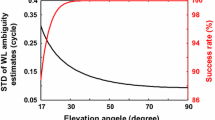Abstract
An investigation has been made on the models and characteristics of triple-frequency carrier-phase linear combinations for the BeiDou Navigation Satellite System (BDS). Based on the three frequencies of the BDS, three categories of combinations are developed: ionosphere-free combinations (i.e., those that eliminate the ionospheric effect), minimum-noise combinations (those that mitigate the effects of thermal noise and multiple paths), and troposphere-free combinations (those that mitigate tropospheric effects). Both the ionosphere-free and troposphere-free combinations can be expressed as planes, whereas the minimum-noise combinations can be expressed as a line. The relationships between these three categories of linear combinations are investigated from the perspective of geometry. The angle between the troposphere-free plane and ionosphere-free plane is small, while the angles between the troposphere-free plane and the minimum-noise line, and between the ionosphere-free plane and the minimum-noise line, are large. Specifically, the troposphere-free plane is orthogonal to the minimum- noise line. By introducing the concepts of lane number and integer ionosphere number, the characteristics of the long-wavelength integer combinations and ionosphere-free integer combinations are investigated. The analysis indicates that the longest wavelength that can be formed for integer combinations is 146.53 m, and the ionosphere-free integer combinations all have large noise amplification factors. The ionosphere-free integer combination with minimum noise amplification factor is (0, 62, 59). According to the lane number, integer ionosphere number, and noise amplification factor, optimal integer combinations with different characteristics are presented. For general short baselines and long baselines, three independent integer combinations are suggested.
Similar content being viewed by others
References
Cocard M, Geiger A. 1992. Systematic search for all possible wide-lanes. Proceedings of the 6th International Geodetic Symposium on Satellite Positioning. 312–318
Cocard M, Bourgon S, Kamali O, et al. 2008. A systematic investigation of optimal carrier-phase combinations for modernized triple-Frequency GPS. J Geodesy, 82: 555–564
Collins J P. 1999. An overview of GPS inter-frequency carrier phase combinations. Technical Report. Geodesy and Geomatics Engineering. University of New Brunswick
Dai Z, Knedlik S, Loffeld O. 2009. Instantaneous triple-frequency GPS cycle-slip detection and repair. Int J Navig Obs, 2009: 407231, doi: 10.1155/2009/407231
De Lacy M C, Reguzzoni M, Sanso F. 2012. Real-time cycle slip detection in triple-frequency GNSS. GPS Solut, 16: 353–362
Feng Y. 2008. GNSS three carrier ambiguity resolution using ionosphere-reduced virtual signals. J Geodesy, 82: 847–862
Feng Y, Li B. 2010. Wide area real time kinematic decimeter positioning with multiple carrier GNSS signals. Sci China Earth Sci, 53: 731–740
Forssell B, Martin-Neira M, Harris R A. 1997. Carrier phase ambiguity resolution in GNSS-2. Proceedings of the ION GPS. 1727–1736
Han S, Rizos C. 1999. The impact of two additional civilian GPS frequencies on ambiguity resolution strategies. Proceedings of ION 55th Annual Meeting. 315–321
Harris R A. 1997. Direct resolution of carrier phase ambiguity by “bridging the wavelength gap”. Technical Report. ESA
Huang L, Song L, Wang Y, et al. 2012. BeiDou triple-frequency geometry-free phase combination for cycle-slip detection and correction (in Chinese). Acta Geodaet Cartograph Sin, 41: 763–768
Li B, Feng Y, Shen Y. 2010. Three carrier ambiguity resolution: Distance-independent performance demonstrated using semi-generated triple frequency GPS signals. GPS Solut, 14: 177–184
Li J, Yang Y, He H, et al. 2012. Optimal carrier-phase combinations for triple-frequency GNSS derived from an analytical method (in Chinese). Acta Geodaet Cartograph Sin, 41: 797–803
Jung J. 1999. High integrity carrier phase navigation for future LAAS using multiple civilian GPS signals. Proceedings of the ION GPS. 14–17
Mordell L J. 1969. Diophantine Equations. New York: Academic Press
Odijk D. 2003. Ionosphere-free phase combinations for modernized GPS. J Surv Eng, 129: 165–173
Richert T, El-Sheimy N. 2007. Optimal linear combinations of triple-frequency carrier phase data from future global navigation satellite systems. GPS Solut, 11: 11–19
Teunissen P J G, Odijk D. 2003. Rank defect integer estimation and phase-only modernized GPS ambiguity resolution. J Geodesy, 76: 523–535
Wang Z, Liu J. 2003. Model of inter-frequency Combinations of Galileo GNSS (in Chinese). Geomat Inf Sci Wuhan Univ, 28: 723–727
Wu Y, Jin S G, Wang Z M, et al. 2010. Cycle-slip detection using multi-frequency GPS carrier phase observations: A simulation study. J Adv Space Res, 46: 144–149
Wu Y, Guo J, Meng Y, et al. 2006. Analysis of GPS multi-frequency carrier phase combinations (in Chinese). Geomat Inf Sci Wuhan Univ, 31: 1082–1085
Xu J, Tao T, Gao F. 2013. Research on three kinds of carrier frequency combination value of GLONASS (in Chinese). J Geod Geodyn, 33: 86–89
Author information
Authors and Affiliations
Corresponding author
Rights and permissions
About this article
Cite this article
Zhang, X., He, X. BDS triple-frequency carrier-phase linear combination models and their characteristics. Sci. China Earth Sci. 58, 896–905 (2015). https://doi.org/10.1007/s11430-014-5027-9
Received:
Accepted:
Published:
Issue Date:
DOI: https://doi.org/10.1007/s11430-014-5027-9




